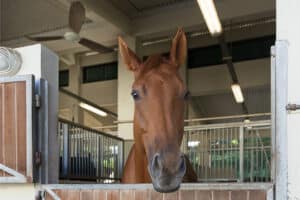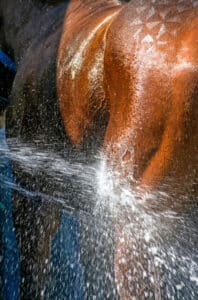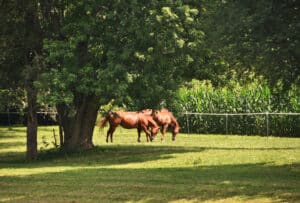Summertime, and the weather is … hot! REBECCA NADGE asked Karen Tinney for advice on how to keep your horse comfortable as the mercury rises.
Although some parts of Australia may be experiencing higher temperatures than others, there’s still plenty to bear in mind when it comes to managing horses in summer. The longer days offer a good opportunity to get outside and spend time with your horse, and your riding needn’t take a break just because the mercury rises.
Karen Tinney of Tinney Eventing says that when it comes to caring for horses in the heat, good management is important both on the ground and under saddle, and it’s important to adapt your expectations depending on the conditions. “You’ll be very surprised how well horses deal with heat if they have shade, if they’re covered, and if they have water. They actually cope a lot better than you think they’re going to. It’s just when you work them in the middle of the day when it’s very, very hot – I think that’s a different thing all together.”
Karen believes that the time of day is crucial when it comes to planning your ride and recommends working horses in the morning rather than the evenings. “In Australia I think humidity has a lot to answer for – you don’t want to be working them during a hot, humid day. I always find early mornings are fresher – even late afternoon you still have that humidity and heat which comes from the soil and the sand.”

If horses are stabled, good ventilation and fans can be used to make them more comfortable.
And exercise should be appropriate for the weather conditions. Riders need to be realistic about what can be achieved – and breaking up the intensity of the session with walks gives the horse time to recover. “For eventers we do need to maintain a length of work for them but you choose your timing,” Karen tells me. “I think it’s particularly important for them because they become so fit that you don’t want to shorten the amount of time that you work them – especially if they’re stabled because you obviously have the possibility of tying up.”
That said, it’s important to recognise that every horse is an individual and to have a good understanding of what is normal for them. “We have a temperature chart recording what their temperatures are at a standing rate in normal circumstances,” Karen explains. “We know that some horses run a little higher in their core temperature than others. I think that’s very important because if you do have a horse than runs a little higher, you don’t want to do intensive work on a very hot day.”
Having a good understanding of each horse’s base temperature also plays a part when it comes to managing their recovery after a workout. “We take temperatures all the time – there’s a thermometer at every corner of our yard. Their temperature indicates how much they’ve been stressed and how hot they are.” The aim is to drop the horse’s core temperature as fast as possible, which involves hosing them with cold water, while ice boots are very effective at cooling down the tendons after work. “The worst thing you can do is make that horse feel that the workout wasn’t very pleasant. It might be a hard workout but you want the recovery to make them feel better,” she adds.

Rapid cooling with ice water helps bring the temperature down as fast as possible.
At home, workouts are managed to ensure the horse’ temperatures never rise above approximately 39.8ºC, but this is likely to be a different story after completing an eleven minute cross country round in the heat. That’s when the Tinney Eventing team opt for rapid cooling with ice water to bring temperatures down as fast as possible. “Interestingly,” Karen comments, “horses’ temperatures tend to go up after ten minutes, or even five minutes, so make sure they’ve fully recovered back to a temperature that you feel is going to be acceptable. For us, that’s 37.8º or 37.9º, and then we often follow that up by putting them in a stable with a fan.”
Recovery after working in the heat is one of the most important parts of the training regime, she tells me: “As an eventer you’re putting a lot of pressure on your horse to use themselves physically and mentally. Making them feel the best they possibly can as they recover is going to be very positive for you horse in the future. There’s not a lot we really use, but we do feel that the system we have tends to work quite well. We rely on our feed regime, workouts that don’t stress them too much, and then the recovery is paramount.”
Karen believes that compression suits help with muscle recovery after a workout and that adequate nutrition is essential. Many complete feeds already contain some electrolytes and therefore it’s important not to overfeed with additional supplements. “We’re big believers in rock salt – all the horses get salt in their morning feed. We definitely feed electrolytes but we only feed them if they’ve sweated and if they’ve had an intense work out. We don’t feed electrolytes seven days a week because electrolytes can be a little bit fickle in their metabolism. Overfeeding electrolytes can actually be detrimental to your training. They can upset the horse’s metabolism and their behaviour can be affected by that – and you need to have them with a trainable brain.”

Shade is a major consideration for horses living out in the paddock.
When it comes to managing wellbeing on the ground, all the Tinney Eventing horses live out in the paddock and therefore shade is a major consideration. Having access to clean, fresh water at all times is also crucial. If horses are stabled, good ventilation plays a part and fans can be used as a way to make them more comfortable. “I think more than anything horses like to maintain a certain temperature, so making sure they’re not rugged too heavily is a big factor.” Karen favours light cotton rugs or those that are half cotton, half mesh. Fly veils are also used to keep them from being hassled by bugs. Horses at the Tinney yard are not worked over the Christmas and New Year period but are still checked daily, before being brought back into work a few weeks prior to their first competition.
Karen has found that a horse’s ability to cope with the heat is generally a natural trait rather than something you can condition them for, and this is something the Tinneys bear in mind when it comes to purchasing potential elite eventers.
Less experienced riders needing to work horses in the heat can benefit from having a good coach that understands both horse and rider. But the importance of understanding what’s normal for your horse can’t be understated. “I think the baseline temperatures are a really good idea – that gives you a bit of an expectation of whether they’re going to run hot or not. It’s about looking at the stamp of horse,” she adds, “Thoroughbreds recover very, very quickly because they’re bred to be able to run and recover well. We think it’s really important to find a horse that suits your discipline, rather than trying to make your horse fit your discipline. We do monitor them a lot – monitor their legs, monitor their temperatures, all sorts of things. There’s a lot more to it than people think,” she laughs.
Feature Image: Stuart Tinney OAM and Leporis competing in the CCN4-S at the 2021 Sydney International 3DE (Image by Franz Venhaus).



